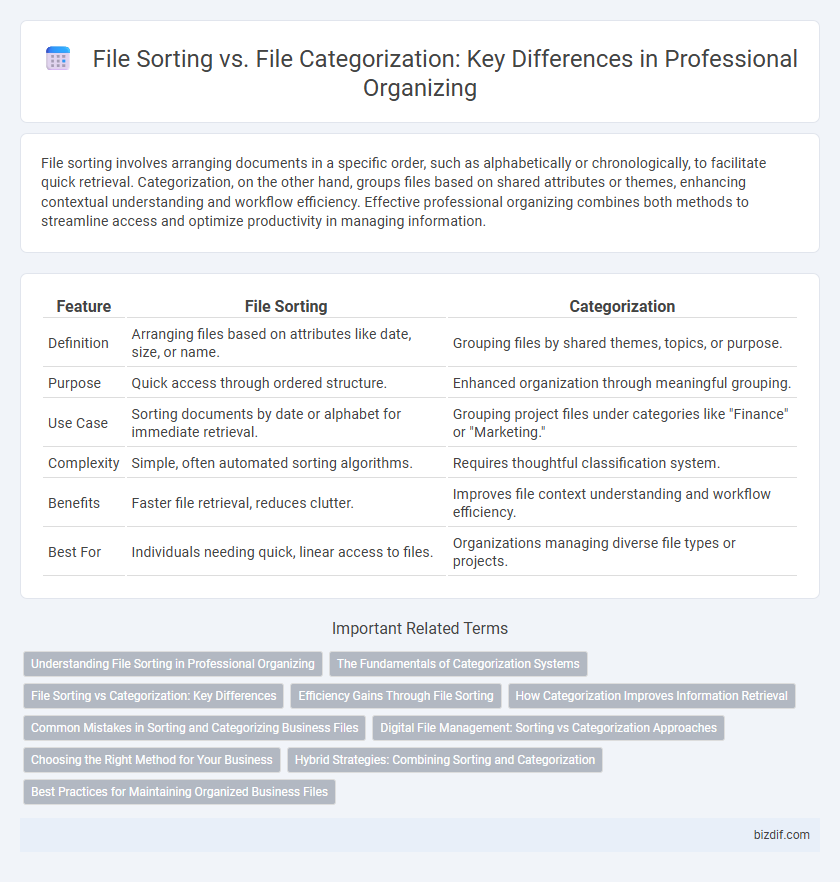File sorting involves arranging documents in a specific order, such as alphabetically or chronologically, to facilitate quick retrieval. Categorization, on the other hand, groups files based on shared attributes or themes, enhancing contextual understanding and workflow efficiency. Effective professional organizing combines both methods to streamline access and optimize productivity in managing information.
Table of Comparison
| Feature | File Sorting | Categorization |
|---|---|---|
| Definition | Arranging files based on attributes like date, size, or name. | Grouping files by shared themes, topics, or purpose. |
| Purpose | Quick access through ordered structure. | Enhanced organization through meaningful grouping. |
| Use Case | Sorting documents by date or alphabet for immediate retrieval. | Grouping project files under categories like "Finance" or "Marketing." |
| Complexity | Simple, often automated sorting algorithms. | Requires thoughtful classification system. |
| Benefits | Faster file retrieval, reduces clutter. | Improves file context understanding and workflow efficiency. |
| Best For | Individuals needing quick, linear access to files. | Organizations managing diverse file types or projects. |
Understanding File Sorting in Professional Organizing
File sorting in professional organizing involves arranging documents based on specific attributes such as date, name, or type to streamline retrieval and enhance efficiency. This process emphasizes the systematic placement of files in a logical order, reducing clutter and saving time during searches. Proper file sorting supports improved workflow by minimizing confusion and ensuring critical information is easily accessible.
The Fundamentals of Categorization Systems
File sorting arranges documents based on specific criteria such as date or size, facilitating quick retrieval of individual items. Categorization systems organize files into meaningful groups according to shared characteristics or functions, enhancing overall efficiency and context understanding. The fundamentals of categorization emphasize consistent labeling, hierarchical structuring, and user-centered design to streamline information management and retrieval.
File Sorting vs Categorization: Key Differences
File sorting arranges documents based on specific criteria such as date, alphabet, or size, enabling quick retrieval and maintaining chronological or numerical order. Categorization, however, groups files by themes, project types, or purposes, facilitating broader organizational clarity and efficient workflow management. Understanding the key differences between file sorting and categorization enhances professional organizing by improving both accessibility and contextual relevance of stored information.
Efficiency Gains Through File Sorting
File sorting enhances professional organizing by streamlining access to documents through systematic arrangement based on attributes like date, type, or priority, significantly reducing retrieval time. This method minimizes clutter and accelerates workflow, as files are quickly identifiable and logically ordered. Efficient file sorting directly contributes to productivity by enabling faster decision-making and reducing time spent on searching for information.
How Categorization Improves Information Retrieval
Categorization enhances information retrieval by grouping files based on shared attributes or themes, allowing quicker identification and access compared to simple file sorting. Unlike sorting, which arranges files alphabetically or chronologically, categorization creates meaningful clusters that reflect the user's workflow and priorities. This structured organization reduces search time and increases efficiency in professional organizing systems.
Common Mistakes in Sorting and Categorizing Business Files
Common mistakes in sorting and categorizing business files include inconsistent labeling, mixing unrelated documents, and overcomplicating folder structures. These errors lead to inefficient file retrieval and increased time spent searching for critical information. Implementing clear naming conventions and consistent categorization criteria significantly enhances organization and boosts productivity.
Digital File Management: Sorting vs Categorization Approaches
Digital file management relies on two key approaches: file sorting and categorization, each enhancing organization efficiency. File sorting arranges documents based on specific attributes like date, name, or file type, enabling quick retrieval in a linear structure. Categorization assigns files to thematic groups or tags, fostering intuitive navigation and cross-referencing across diverse digital environments.
Choosing the Right Method for Your Business
File sorting organizes documents by date, size, or name for quick retrieval, ideal for businesses with chronological or numerical records. Categorization groups files by topics, projects, or departments, enhancing thematic access and collaboration. Assess your business needs--transactional processes benefit from sorting, while creative or cross-functional teams excel with categorization.
Hybrid Strategies: Combining Sorting and Categorization
Hybrid strategies in professional organizing blend file sorting and categorization to optimize document management and retrieval efficiency. By integrating chronological or alphabetical sorting with thematic categorization, organizers create a multi-layered system that enhances both accessibility and contextual understanding. This approach reduces clutter and improves workflow by allowing users to quickly locate files within logically grouped categories and sorted sequences.
Best Practices for Maintaining Organized Business Files
File sorting involves arranging documents chronologically or alphabetically, ensuring quick retrieval based on time or name. Categorization groups files by project, client, or document type, enhancing thematic organization and reducing search time. Combining both methods with consistent labeling and digital backups optimizes efficiency and maintains long-term order in business file management.
File sorting vs Categorization Infographic

 bizdif.com
bizdif.com